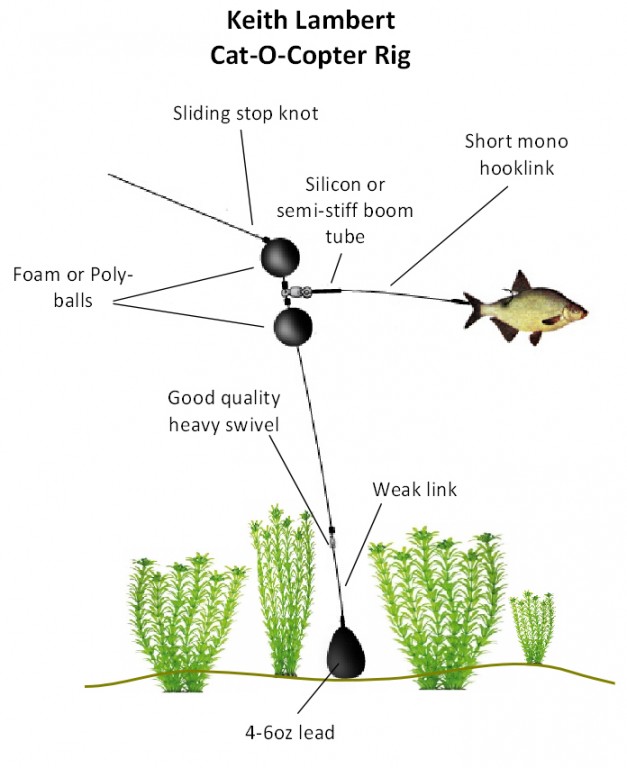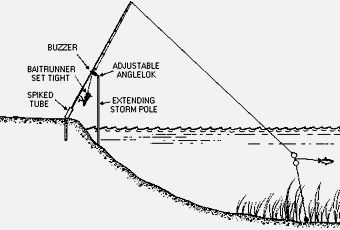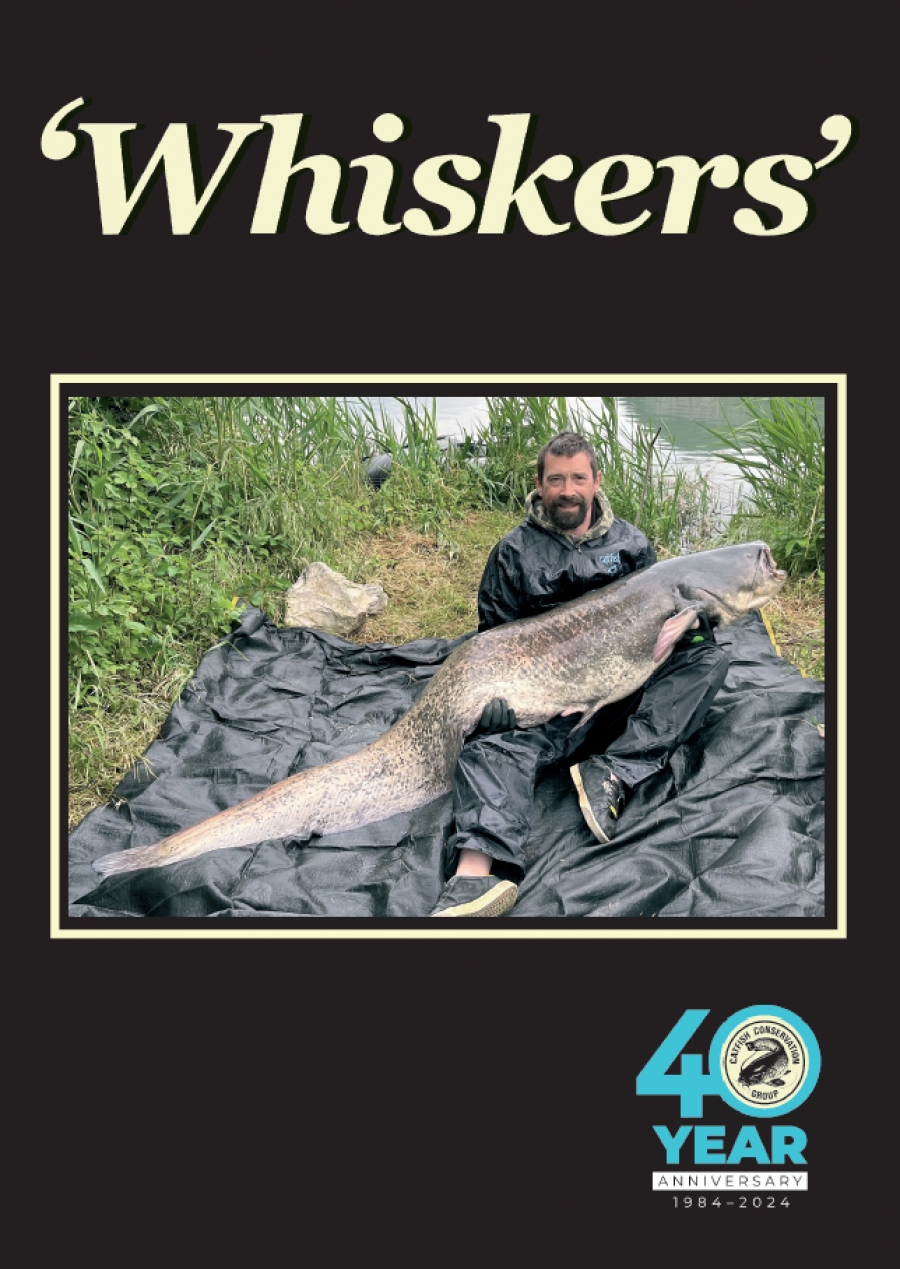


The original ‘Keith Lambert Cat-O-Copter' is a rig that was first publicised around 15 or 16 years ago after much testing and many catfish captures. The rig was highly successful on many waters and accounted for several new lake records including the current British record catfish. Like most things development continued and the rig was ‘updated' and tinkered with.
The following account is Keith Lambert's own detail of this rig but it can of course be adapted to suit individual requirements. The beauty of the Cat-O-Copter Rig is that it allows you to fish a bait at any depth simply by adjusting the sliding stop knot. The rig is best explained with the help of a diagram.
 I will explain the setup starting from the bottom. The lead needs to be large as you don't want a lively bait towing it around, also when you get a take it is preferable that the catfish pulls line from the baitrunner rather than dragging a lead; For this reason I will often use a bomb of 4 to 6 ounces, I like the flat sided ones best. Next comes the lead link or rotten bottom, this is usually old monofilament of around 6 or 8 pounds breaking strain. I will generally use around three or four feet unless I want to fish directly over a weed bed, then it will be a couple of feet longer than the weed is deep. It is not usually possible to fish over weed that extends more than about seven or eight feet from the bottom. The bomb link is tied to a large, strong swivel, I only use Berkley. The main line is tied to the other eye of the swivel having first threaded on the following components; a small eyed bead; a high density polyball or foam ball of around 1 inch - 2 inch diameter, another bead followed by a swivel, then another bead, another polyball (same size), a bead and finally a rubber shock bead or two. I know it sounds complicated, but trust me, it's actually very simple. The hook link needs to be short, I generally make mine about 8 to ten inches. My favourite material is Seaguar fluorocarbon but any stiff mono will do. Don't use Dacron, Braids etc. they are not stiff enough and will guarantee tangles. Choice of hook is always a personal thing but I favour either Owner SSW Circles in sizes 2 - 4/0, or VMC Sport Circles in sizes 1/0 - 3/0. Next slide about six inches of silicone tubing or semi-stiff boom tube over the hooklength before tying it to the free eye of the sliding swivel, then push the tubing over the swivel to create a boom. The last thing is a sliding stop knot that needs to be tied above the small eyed bead. This knot will determine the depth at which the bait will fish. When you are ready to cast in, the rig will slide down into the bottom swivel and spin helicopter style. As you will only have the length of the bomb link hanging, casting is no problem, in fact this rig can happily be cast great distances without problems (except that your livebaits get headaches).
I will explain the setup starting from the bottom. The lead needs to be large as you don't want a lively bait towing it around, also when you get a take it is preferable that the catfish pulls line from the baitrunner rather than dragging a lead; For this reason I will often use a bomb of 4 to 6 ounces, I like the flat sided ones best. Next comes the lead link or rotten bottom, this is usually old monofilament of around 6 or 8 pounds breaking strain. I will generally use around three or four feet unless I want to fish directly over a weed bed, then it will be a couple of feet longer than the weed is deep. It is not usually possible to fish over weed that extends more than about seven or eight feet from the bottom. The bomb link is tied to a large, strong swivel, I only use Berkley. The main line is tied to the other eye of the swivel having first threaded on the following components; a small eyed bead; a high density polyball or foam ball of around 1 inch - 2 inch diameter, another bead followed by a swivel, then another bead, another polyball (same size), a bead and finally a rubber shock bead or two. I know it sounds complicated, but trust me, it's actually very simple. The hook link needs to be short, I generally make mine about 8 to ten inches. My favourite material is Seaguar fluorocarbon but any stiff mono will do. Don't use Dacron, Braids etc. they are not stiff enough and will guarantee tangles. Choice of hook is always a personal thing but I favour either Owner SSW Circles in sizes 2 - 4/0, or VMC Sport Circles in sizes 1/0 - 3/0. Next slide about six inches of silicone tubing or semi-stiff boom tube over the hooklength before tying it to the free eye of the sliding swivel, then push the tubing over the swivel to create a boom. The last thing is a sliding stop knot that needs to be tied above the small eyed bead. This knot will determine the depth at which the bait will fish. When you are ready to cast in, the rig will slide down into the bottom swivel and spin helicopter style. As you will only have the length of the bomb link hanging, casting is no problem, in fact this rig can happily be cast great distances without problems (except that your livebaits get headaches).
Once you have cast in, the buoyancy of the polyballs will slide your bait up the line until it reaches the stop knot, that is the depth that it will fish if you don't tighten down. Normally anglers will tighten down to the lead and put the rod on a standard rod rest / buzzer or a rod pod; This would have the effect of pulling the bait much lower in the water which rather defeats the object. The secret, and this is the bit that gets all the laughs, is to fish your rods beach caster style. I use a rear rest, like the things that matchmen use to store their poles upright, basically it is a tube with a spike on one end which is pushed into the ground. The front rest is an extended storm pole. It needs to be about five or six feet long, this has an adjustable keepnet angle screwed into it, on which is mounted the buzzer. The effect of this contraption is simply to keep the rod pointed skywards whilst allowing the line to run across the bite alarm at its usual angle (90 degrees or so).  The rig is fished without a bobbin, straight from the Baitrunner which is adjusted to the tight setting to stop the bait taking line. It is amazing how sensitive this setup is; when you see what the bait does to the rod tip you will see what I mean, even the livebait knocking makes me confident. The livebait, incidentally, can be hooked either through the nostrils or through the root of the tail which tends to encourage the fish to swim away from the rig and stay lively. I have found this rig to be largely tangle proof when used as I have described. After much experimentation I have decided that this is the best setup although I am happy for people to improve it in any way that they can. Several anglers have expressed concern about the fact that the full weight of the fish is pulling down onto the bottom polyball when you are playing it, I can honestly say that I have never lost a fish on this rig due to tackle failure. Please use it and let me know how you get on; It does work.
The rig is fished without a bobbin, straight from the Baitrunner which is adjusted to the tight setting to stop the bait taking line. It is amazing how sensitive this setup is; when you see what the bait does to the rod tip you will see what I mean, even the livebait knocking makes me confident. The livebait, incidentally, can be hooked either through the nostrils or through the root of the tail which tends to encourage the fish to swim away from the rig and stay lively. I have found this rig to be largely tangle proof when used as I have described. After much experimentation I have decided that this is the best setup although I am happy for people to improve it in any way that they can. Several anglers have expressed concern about the fact that the full weight of the fish is pulling down onto the bottom polyball when you are playing it, I can honestly say that I have never lost a fish on this rig due to tackle failure. Please use it and let me know how you get on; It does work.
© Keith Lambert

This mid 30 fell to a small perch fished on a Cat-O-Copter Rig

Out Now!
Whiskers magazine is Free to all members!
Non-members can purchase previous copies from the Membership Secretary